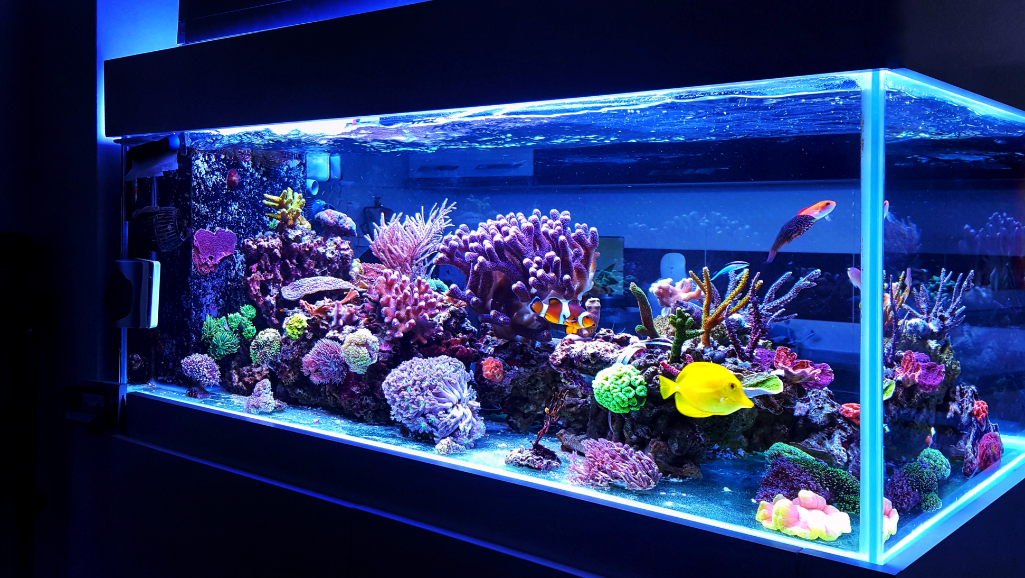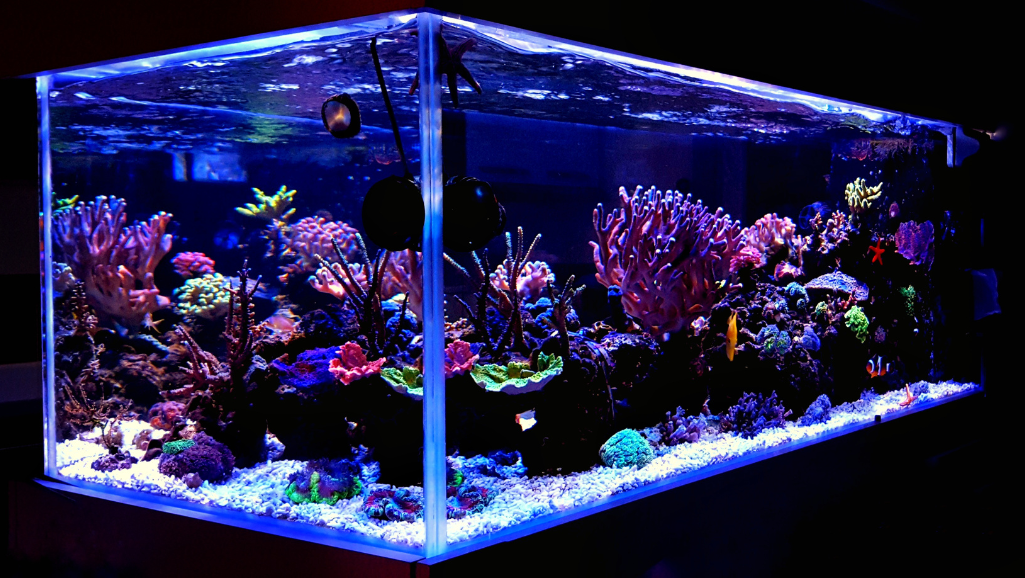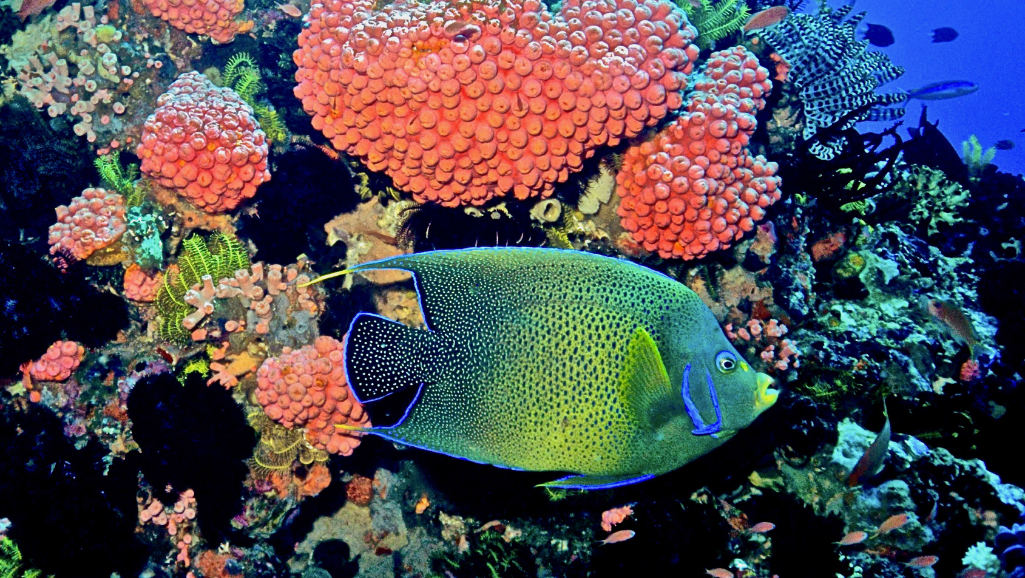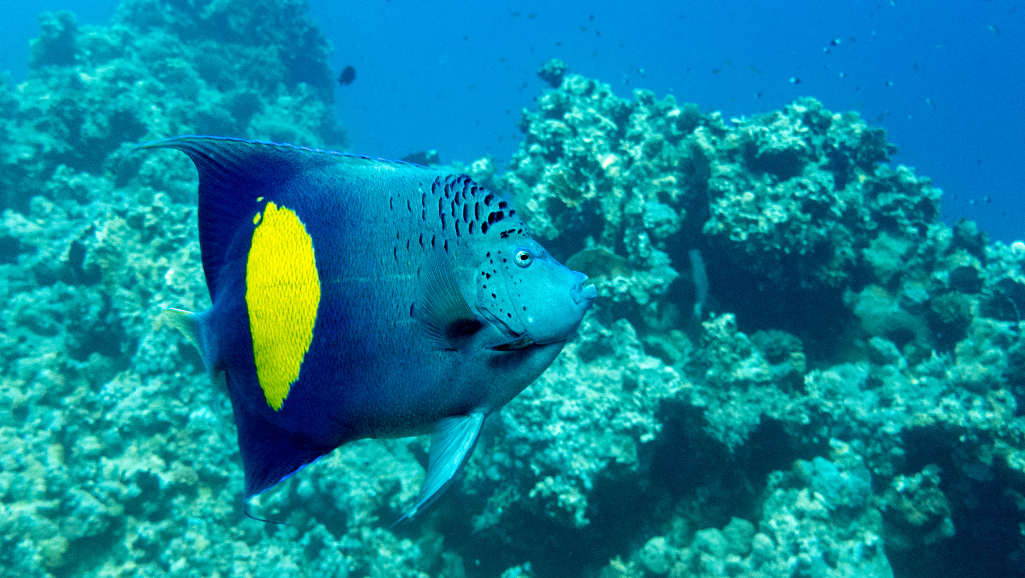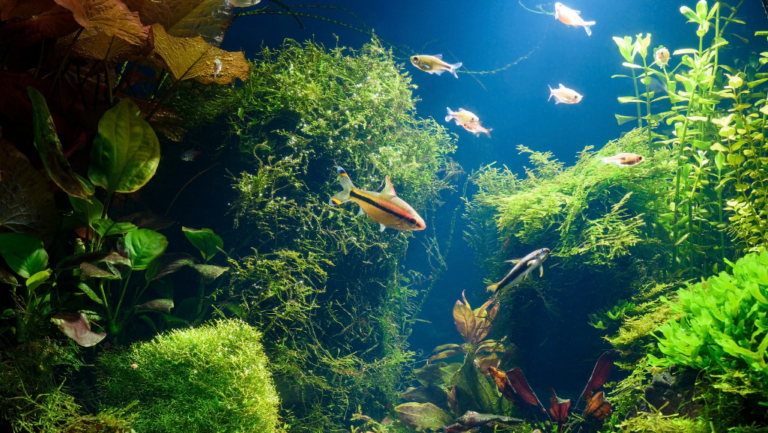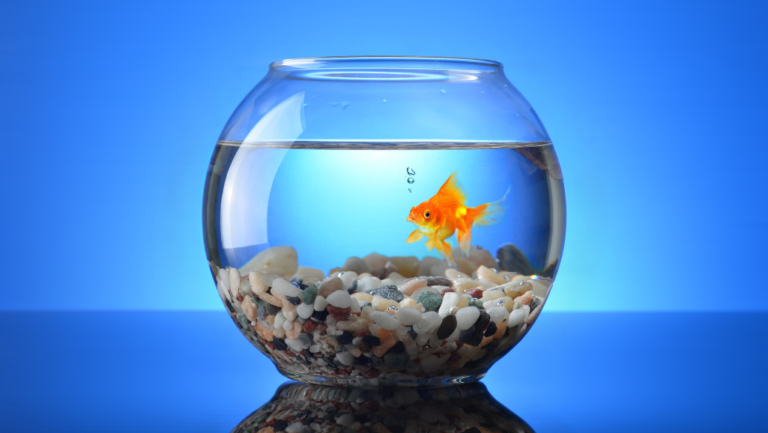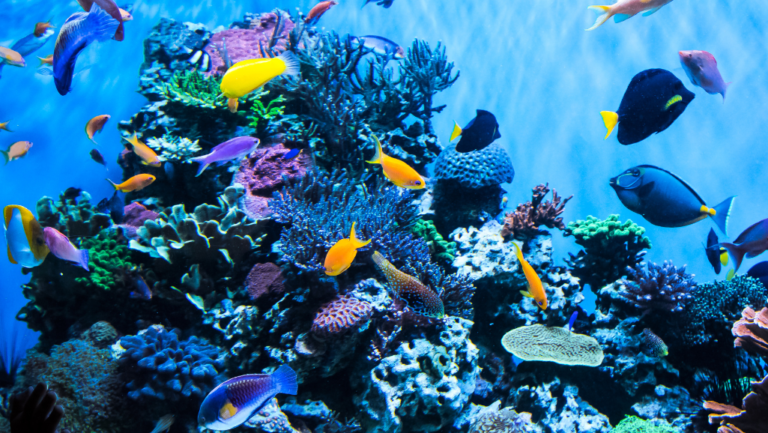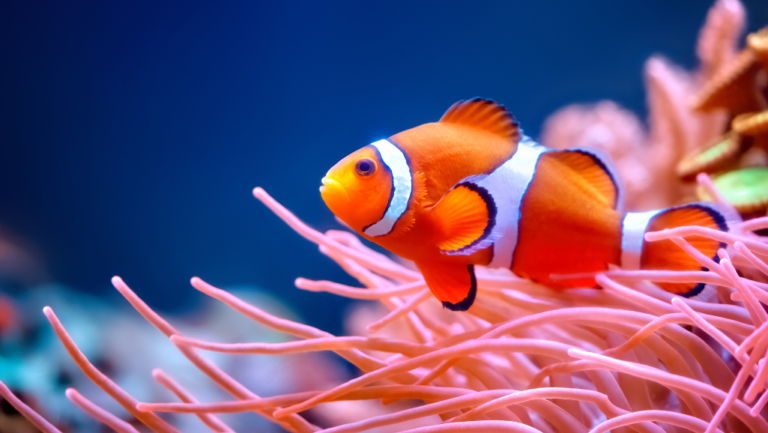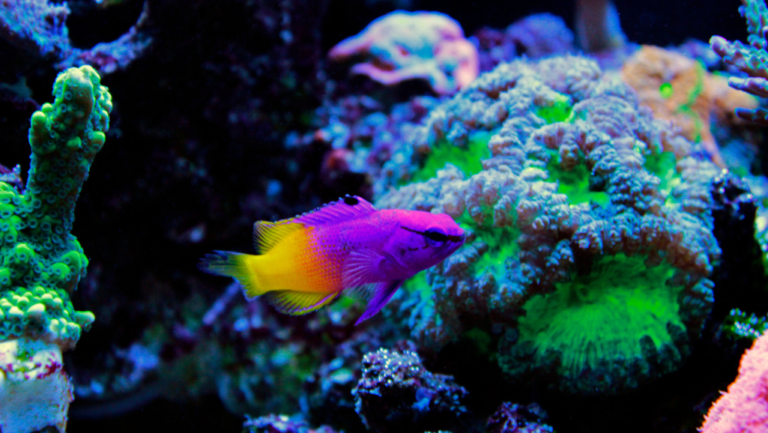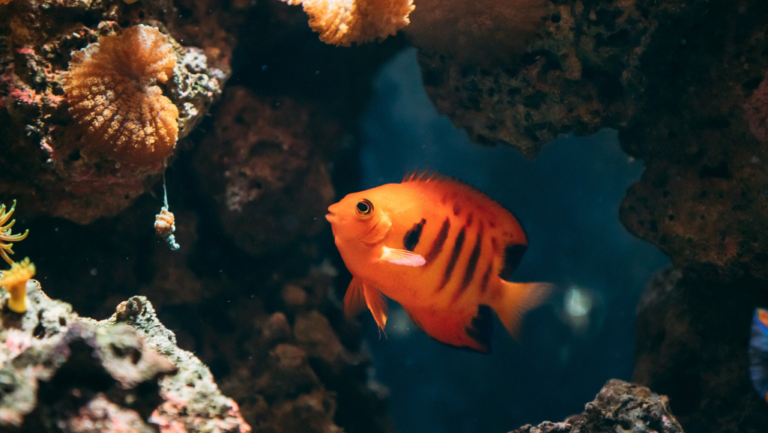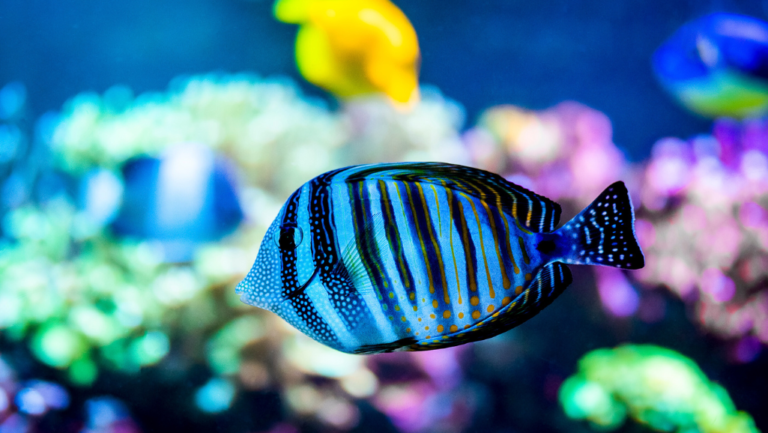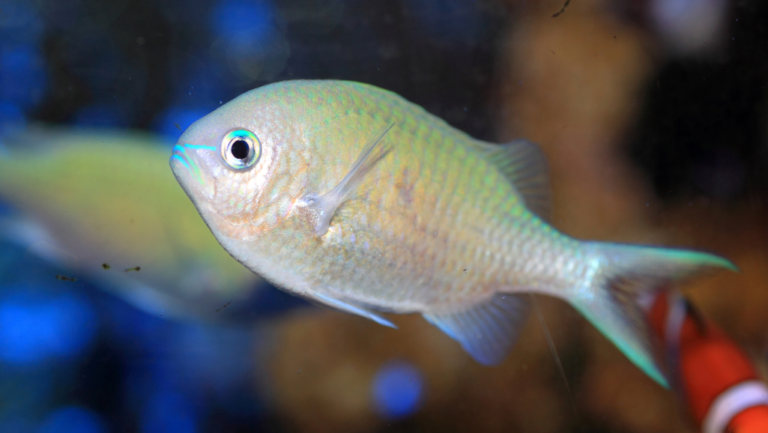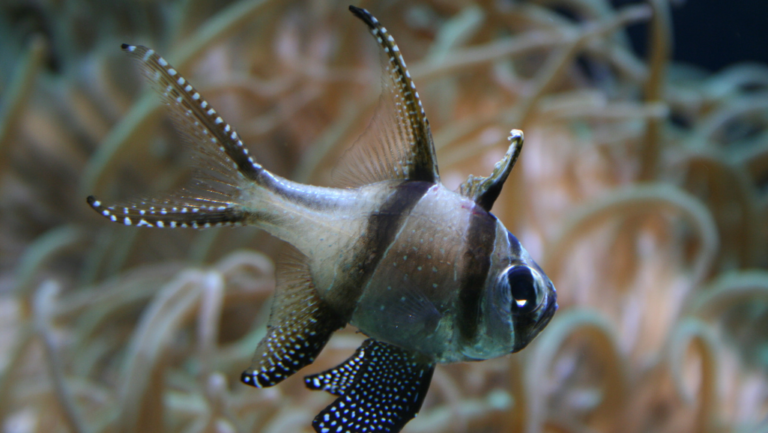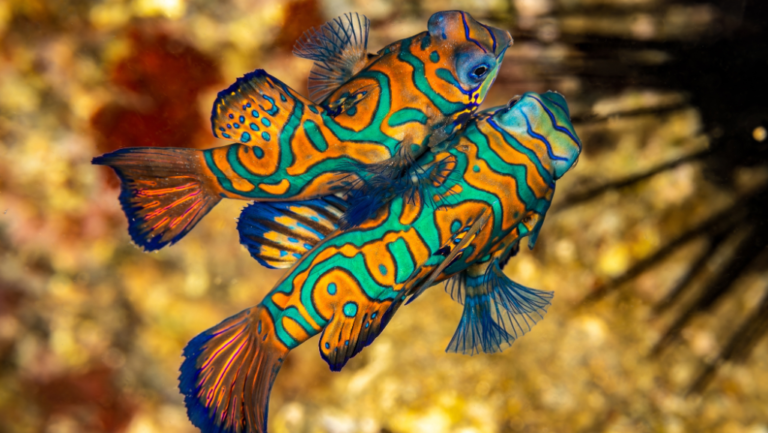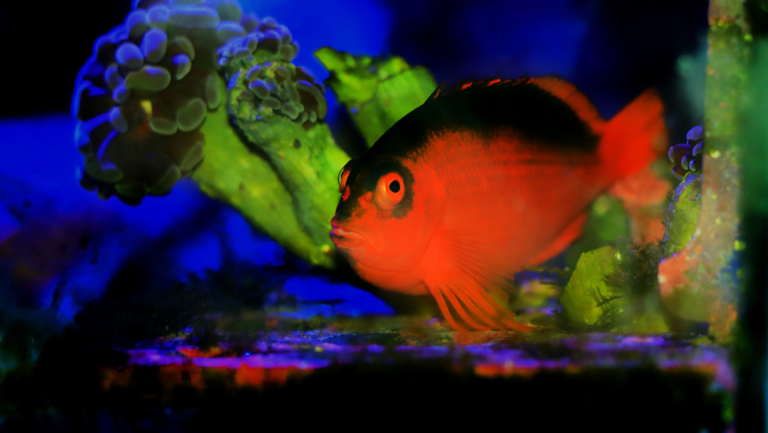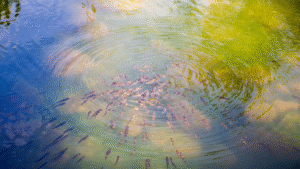The beauty of a marine hobby lies in the vibrant life under the sea. The Coral Beauty Angelfish, with their stunning colors, bring life to any vibrant aquarium. To keep these fish healthy and happy, a detailed care guide is key for any aquarium lover.
The Coral Beauty Angelfish, known scientifically as Centropyge bispinosa, come from the Indo-Pacific. They thrive in places like the Great Barrier Reef. Their bright colors and lively fins make them a favorite in the marine hobby. These angelfish are great for beginners, as they prefer standard marine conditions and are easy to care for.
Key Takeaways
- Tank Size: A minimum of 70 gallons is needed for enough space and to prevent territorial behavior.
- Temperature: The water should be between 72-78°F for their health and comfort.
- Salinity: Keep the water’s salinity at 1.020-1.025 to match their natural home.
- pH Levels: The pH should be between 8.0-8.4 for a good living space.
- Diet: Feed them a mix of foods, leaning towards more plant-based options.
- Reef Compatibility: They are generally safe for reefs but watch out for coral nipping.
- Captive-Bred Health: Choose captive-bred Coral Beauty Angelfish for better health and disease resistance.
Introduction to Coral Beauty Angelfish
Starting a journey with Coral Beauty Angelfish means loving their beauty and role in the ocean. These reef safe fish are not just pretty. They also help keep the ocean healthy.
The many marine species let us create amazing ocean worlds at home. The Coral Beauty Angelfish is key to this. It’s a favorite among both new and experienced fish keepers.
Overview of the Species
The Coral Beauty Angelfish stands out for its strength and color. It’s great with other fish, making it perfect for a lively tank.
Natural Habitat and Behavior
In the wild, Coral Beauty Angelfish live in reefs and lagoons. They show off their bright colors, making any tank look amazing. Knowing how they act and like their space is important for a good home.
Importance in Home Aquariums
Choosing captive-bred Coral Beauty Angelfish helps the fishkeeping world. It also makes these fish live longer and healthier in our tanks. They add beauty and life to our saltwater aquariums.
Setting Up the Ideal Aquarium
To create the perfect home for Coral Beauty Angelfish, start with the right tank size. A 46-gallon Bowfront System II Aquarium is ideal. It offers enough space for swimming and territorial behaviors.
Tank Size and Dimensions
The 46-gallon Bowfront System II Aquarium is a great choice. It balances beauty with function. This size helps create a complex environment, vital for the health of Coral Beauty Angelfish.
Essential Equipment and Filtration
- A 100W Visi-Therm heater keeps the water at the right temperature. This is key for a healthy marine ecosystem.
- The Prizm Skimmer helps remove waste, keeping the water clear and healthy.
Tools like Reef Supplements are also important. They include Iodine, Calcium, Buffer, and Strontium/Molybdenum. These help keep the water quality high and support coral growth.
Substrate and Decoration Choices
Choose decorations and substrates that mimic the fish’s natural habitat. Live rock structures are great for hiding spots and biological filtration. They also support algae growth, which is good for grazing.
Setting up the perfect saltwater aquarium requires careful planning. The right tank size, filtration, and heating systems are key. So are the right substrates and decorations. These steps will help your Coral Beauty Angelfish thrive.
Water Conditions for Coral Beauty Angelfish
Keeping the water in a saltwater aquarium just right is key for the health of marine fish like the Coral Beauty Angelfish. The right temperature, salinity, and pH levels are critical. They can mean the difference between a healthy and a struggling aquarium.
Temperature and pH Requirements
The Coral Beauty Angelfish loves water between 72-78°F (22-25.5°C). Keeping the temperature steady in this range is important to avoid stressing the fish. Also, the pH level should be between 8.0 and 8.4. This helps mimic the ocean and supports the health of marine life.
Salinity Levels and Specific Gravity
The specific gravity, or saltiness of the water, should be between 1.020 and 1.025. This is important for the health of marine fish like the Coral Beauty Angelfish. It helps them regulate their body’s balance.
Regular Water Testing and Maintenance
Testing the water regularly is essential to catch any harmful changes. It’s best to do water changes of 10-15% every two weeks. This keeps the water quality high and removes waste, creating a clean home for the Coral Beauty Angelfish.
Feeding Your Coral Beauty Angelfish
Feeding your Coral Beauty Angelfish right is key to their health and color. These fish are omnivorous, needing a mix of foods to stay healthy. Knowing this helps you feed them well and keep your tank balanced.
Recommended Diet Options
Coral Beauty Angelfish love to eat plants but also need protein. A good aquarium diet should have:
- Marine algae or spirulina pellets.
- Nori sheets, which can be attached to the tank sides or special feeders.
- Frozen foods like mysis shrimp and brine shrimp, thawed before feeding.
- Live treats like blood worms for variety and fun.
Feeding Frequency and Portions
Feed your Coral Beauty Angelfish small amounts often. This:
- Helps keep the tank clean by reducing waste.
- Prevents obesity and health issues from too much food.
- Makes sure they’re foraging, which is good for their health.
Common Feeding Mistakes to Avoid
Even experts can make mistakes with food. Avoid these common ones:
- Overfeeding: Too much food can harm the tank’s water quality and increase disease risk.
- Underfeeding: Not enough food can leave your fish hungry and unhealthy.
- Ignoring their plant needs: Not enough plant food can cause them to eat your corals.
Following these tips will keep your Coral Beauty Angelfish healthy and your tank thriving.
Tank Mates for Coral Beauty Angelfish
Choosing the right tank mates is key for your Coral Beauty Angelfish. This ensures a peaceful and stress-free home for them. It’s important to pick tank mates that match their needs and temperament.
Compatible Fish and Invertebrates
The Coral Beauty Angelfish gets along well with many peaceful species. Good friends include larger gobies, clownfish, and tangs. They like the same home and don’t fight much. Starfish, shrimps, and snails are also great friends, helping keep the tank clean.
Considerations for Tank Cohabitation
For a harmonious tank, plan carefully and think about space. A 70-gallon tank is a good size for everyone. It gives enough room for hiding and swimming, which helps keep fish calm. Also, add your Coral Beauty Angelfish last to avoid fights with other fish.
Signs of Aggression and Stress
Watch for signs of stress or aggression in your Coral Beauty Angelfish. If they start nipping at others or change their eating habits, it’s a warning sign. This could mean the tank is too crowded or lacks hiding spots. Make sure the tank is balanced and has enough resources for all fish.
By choosing the right tank mates and creating a comfortable home, you can make a thriving community tank. Keep an eye on your fish and take steps to prevent problems. This way, your Coral Beauty Angelfish and their friends will thrive, making your aquarium a vibrant and healthy place for all.
Health and Disease Prevention
Coral Beauty Angelfish are vibrant and healthy in home aquariums with good care. They can get sick, which can spread fast in your tank. It’s important to keep them healthy.
Common Health Issues in Coral Beauty Angelfish
Watch out for diseases like ich and marine velvet. On 12/1/14, a fish showed dark skin, a warning sign. Tiny white spots in 6/17/12 were a sign of disease. These cases show the need for good health care and prevention.
Signs of Stress and Illness
Stress and illness can show in many ways. Cloudy spots or sudden behavior changes are signs. On 6/6/12, a fish ate less due to stress and poor environment.
Proactive Health Management Strategies
Good health care includes watching your fish closely, checking water, and feeding them right. A varied diet helps them stay strong. A tank’s setup and water quality are key to preventing disease.
Learn more about keeping coral colonies healthy in your tank. Check out common coral diseases and treatments. Also, find out how to care for peaceful fish like Cardinal Tetras at AquaJoyLife.

